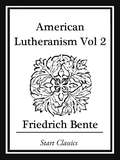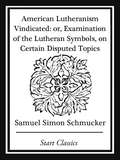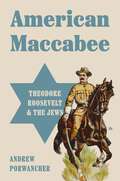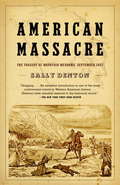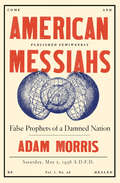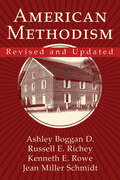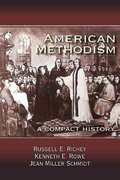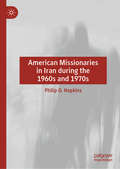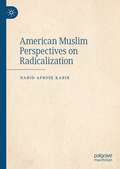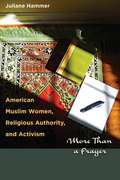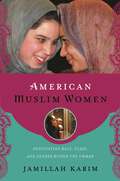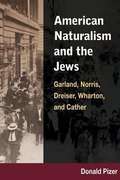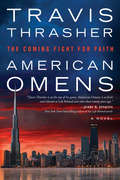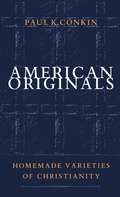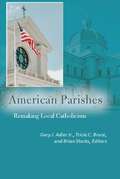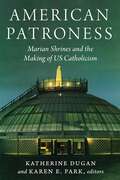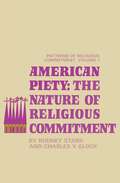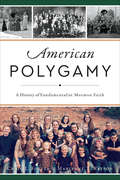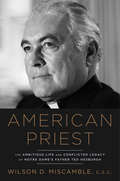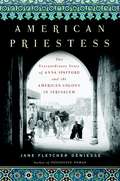- Table View
- List View
American Lutheranism
by Friedrich Bente"American Lutheranism Vol 2" is a religious text written by Friedrich Bente.
American Lutheranism Vindicated: or, Examination of the Lutheran Symbols, on Certain Disputed Topics
by Samuel Simon Schmucker"American Lutheranism Vindicated: or, Examination of the Lutheran Symbols, on Certain Disputed Topics" is a religious text written by Samuel Simon Schmucker.
American Maccabee: Theodore Roosevelt and the Jews
by Andrew PorwancherA major biography of a mesmerizing statesman whose complex bond with the Jewish people forever shaped their lives—and his legacyA scion of the Protestant elite, Theodore Roosevelt was an unlikely ally of the waves of impoverished Jewish newcomers who crowded the docks at Ellis Island. Yet from his earliest years he forged ties with Jews never before witnessed in a president. American Maccabee traces Roosevelt&’s deep connection with the Jewish people at every step of his dazzling ascent. But it also reveals a man of contradictions whose checkered approach to Jewish issues was no less conflicted than the nation he led.As a rising political figure in New York, Roosevelt barnstormed the Lower East Side, giving speeches to packed halls of Jewish immigrants. He rallied for reform of the sweatshops where Jewish laborers toiled for pitiful wages in perilous conditions. And Roosevelt repeatedly venerated the heroism of the Maccabee warriors, upholding those storied rebels as a model for the American Jewish community. Yet little could have prepared him for the blood-soaked persecution of Eastern European Jews that brought a deluge of refugees to American shores during his presidency. Andrew Porwancher uncovers the vexing challenges for Roosevelt as he confronted Jewish suffering abroad and antisemitic xenophobia at home.Drawing on new archival research to paint a richly nuanced portrait of an iconic figure, American Maccabee chronicles the complicated relationship between the leader of a youthful nation and the people of an ancient faith.
American Massacre: The Tragedy At Mountain Meadows, September 1857
by Sally DentonControversy has raged over identity of the organizers and participants of the "Mountain Meadows Massacre" ever since a California-bound wagon train was beset in Utah Territory in 1857 by local Mormons and Paiute Indians (as the story is conventionally told--Paiutes contest this version and are now supported by physical evidence), killing all but seven of the 140 emigrants over the course of four days. The only person ever held criminally responsible for the crime, John D. Lee, was executed 20 years later, condemning the Mormon Church Leaders as the real instigators of the crime. Investigative reporter Denton revisits those events, exploring the development and aftermath of the episode, concluding that Brigham Young and other church leaders were indeed responsible. Annotation (c)2003 Book News, Inc., Portland, OR (booknews.com)
American Messiah: The Surprisingly Simple Religious Views of Thomas Jefferson
by M. Andrew HolowchakUncover the truth of Jefferson’s widely mistaken religious views.Many have written about Thomas Jefferson’s religious views, especially given his views on freedom of religion. Yet with so much written, scholars have not come close to a historical consensus on his religious motivations, leaving literature on Jefferson in disarray. Conversely, American Messiah traces Jefferson’s views of God from his beliefs in early life to his later commitments to Unitarianism, explicating Jefferson’s observations on religion and the impact they had on his overall understanding of faith.In American Messiah, Holowchak delivers a cohesive account of Jefferson’s perception of religion, including these aspects of Jefferson’s surprisingly simple religious beliefs:• True religion, for Jefferson, was equivalent to the axial principles of morality, concerning our duties to God and to man.• Jefferson did not believe in an afterlife late in life, and likely never believed in it.• Jefferson’s commitment to Unitarianism was not a commitment to a particular religious sect, but merely a commitment to a meta- or naturalized religion—the principles of the moral sense.• Freedom of religion, for Jefferson, was not driven by respect for the various religious sects, but by disdain for the baneful consequences of the sham and artificial metaphysical squabbles of religious sectarianism.
American Messiahs: False Prophets Of A Damned Nation
by Adam MorrisA history with sweeping implications, American Messiahs challenges our previous misconceptions about “cult” leaders and their messianic power. Mania surrounding messianic prophets has defined the national consciousness since the American Revolution. From Civil War veteran and virulent anticapitalist Cyrus Teed, to the dapper and overlooked civil rights pioneer Father Divine, to even the megalomaniacal Jim Jones, these figures have routinely been dismissed as dangerous and hysterical outliers. After years of studying these emblematic figures, Adam Morris demonstrates that messiahs are not just a classic trope of our national culture; their visions are essential for understanding American history. As Morris demonstrates, these charismatic, if flawed, would-be prophets sought to expose and ameliorate deep social ills—such as income inequality, gender conformity, and racial injustice. Provocative and long overdue, this is the story of those who tried to point the way toward an impossible “American Dream”: men and women who momentarily captured the imagination of a nation always searching for salvation.
American Metaphysical Religion: Esoteric and Mystical Traditions of the New World
by Ronnie PontiacAn in-depth exploration of four centuries of American occult and spiritual history, from colonial-era alchemists to 20th-century teachers• Details how, from the very beginning, America was a vibrant blend of beliefs from all four corners of the world• Looks at well-known figures such as Manly P. Hall and offers riveting portraits of many lesser known esoteric luminaries such as the Pagan Pilgrim, Tom Morton• Reveals the Rosicrucians among the first settlers from England, the spiritual influence of enslaved people, the work of mystical abolitionists, and how Native Americans and Latinx people helped shape contemporary spiritualityMost Americans believe the United States was founded by pious Christians. However, as Ronnie Pontiac reveals, from the very beginning America was a vibrant blend of beliefs from all four corners of the world. Based on the latest research, with the assistance of leading scholars, this in-depth exploration of four centuries of American occult and spiritual history looks at everything from colonial-era alchemists, astrologers, and early spiritual collectives to Edgar Cayce, the Hermetic Brotherhood of Luxor, and St. Germain on Mount Shasta. Pontiac shows that Rosicrucians were among the first settlers from England and explores how young women of the Shaker community fell into trances and gave messages from the dead. He details the spiritual influence of the African diaspora, the work of mystical abolitionists, and how Indigenous groups and Latinx people played a large role in the shaping of contemporary spirituality and healing practices. The author looks at well-known figures such as Manly P. Hall and lesser known esoteric luminaries such as the Pagan Pilgrim, Tom Morton. He examines the Aquarian Gospel, the Sekhmet Revival, A Course in Miracles, the School of Ageless Wisdom, and mediumship in the early 20th century. He explores the profound influence of the Bodhi Tree Bookstore in Los Angeles and looks at the evolution of female roles in spirituality across the centuries. He also examines the right wing of American metaphysics from the Silver Legion to QAnon. Revealing the diverse streams that run through America&’s metaphysical landscape, Pontiac offers an encyclopedic examination of occult teachers, esotericists, and spiritual collectives almost no one has heard of but who were profoundly influential.
American Methodism Revised and Updated
by Russell E. Richey Kenneth E. Rowe Jean Miller Schmidt Ashley BogganThe essential guide to American Methodism revised and updated through 2020.Four of Methodism’s most respected teachers give us a vivid picture of 260 years of Methodist experience in America. The revised edition updates the Methodist movement’s story through 2020, including the social, political, economic, technological, and global disruptions that cause faith communities and denominations to pull apart.American Methodism Revised and Updated begins with the explosion of evangelical Pietism and revolutionary Methodism, the First Great Awakening, as an independent nation was formed.It then highlights key 19th century themes and Methodist contributions, such as spreading scriptural holiness through missions and literature, planting tens of thousands of Sunday schools and churches by Circuit Riders, the pivotal Methodist schism between abolitionists and enslavers, the innovative building of schools and hospitals into the next century, and the revivalism of the Second Great Awakening.Finally it explores the movements of 20th century Methodism, including the expansion of home and foreign missions, the Methodist drive for Prohibition, the decision for nationwide reunification on the cusp of World War II, reunification with the United Brethren during the Vietnam War, the Methodist ordination of women during the 1950s, Black Methodist leadership in the 1960s Civil Rights movement, and the liturgical renewal or reformation of worship (ancient and future).
American Methodism: A Compact History
by Russell E. Richey Kenneth E. Rowe Jean Miller SchmidtIn this engaging and artful overview, Russell Richey, Kenneth Rowe, and Jean Miller Schmidt, some of Methodism’s most respected teachers, give readers a vivid picture of soulful terrain of the Methodist experience in America. The authors highlight key themes and events that continue to shape the Church. Knowing their history, Methodists are better positioned, prepared, and inspired for faithful witness and holy living.
American Misfits and the Making of Middle-Class Respectability
by Robert WuthnowHow American respectability has been built by maligning those who don't make the gradeHow did Americans come to think of themselves as respectable members of the middle class? Was it just by earning a decent living? Or did it require something more? And if it did, what can we learn that may still apply?The quest for middle-class respectability in nineteenth-century America is usually described as a process of inculcating positive values such as honesty, hard work, independence, and cultural refinement. But clergy, educators, and community leaders also defined respectability negatively, by maligning individuals and groups—“misfits”—who deviated from accepted norms.Robert Wuthnow argues that respectability is constructed by “othering” people who do not fit into easily recognizable, socially approved categories. He demonstrates this through an in-depth examination of a wide variety of individuals and groups that became objects of derision. We meet a disabled Civil War veteran who worked as a huckster on the edges of the frontier, the wife of a lunatic who raised her family while her husband was institutionalized, an immigrant religious community accused of sedition, and a wealthy scion charged with profiteering.Unlike respected Americans who marched confidently toward worldly and heavenly success, such misfits were usually ignored in paeans about the nation. But they played an important part in the cultural work that made America, and their story is essential for understanding the “othering” that remains so much a part of American culture and politics today.
American Missionaries in Iran during the 1960s and 1970s
by Philip O. HopkinsThis work explores the interaction of American Protestant missionaries with Iranians during the 1960s and 1970s. It focuses on the missionary activities of four American Protestant groups: Presbyterians, Assemblies of God, International Missions, and Southern Baptists. It argues that American missionaries’ predisposition toward their own culture confused their message of the gospel and added to the negative perception of Christianity among Iranians. This bias was seen primarily in the American missionaries’ desire to modernize Iran through education and healthcare, and between the missionaries’ relationship with Iranian Christians. Iranian attitudes towards missionary involvement in these areas are investigated, as is the changing American missionary strategy from a traditional method where missionaries had the final say on most matters related to American and Iranian Christian interaction, to the beginnings of an indigenous system where a partnership developed between the missionary and the Iranian Christian.
American Monsters: A History of Monster Lore, Legends, and Sightings in America
by Linda S. GodfreyFrom pre-Columbian legends to modern-day eyewitness accounts, this comprehensive guide covers the history, sightings and lore surrounding the most mysterious monsters in America--including Bigfoot, the Jersey Devil, and more. Bigfoot, the chupacabra, and thunderbirds aren't just figments of our overactive imaginations--according to thousands of eyewitnesses, they exist, in every corner of the United States. Throughout America's history, shocked onlookers have seen unbelievable creatures of every stripe--from sea serpents to apelike beings, giant bats to monkeymen--in every region. Author, investigator, and creature expert Linda S. Godfrey brings the same fearless reporting she lent to Real Wolfmen to this essential guide, using historical record, present-day news reports, and eyewitness interviews to examine this hidden menagerie of America's homegrown beasts.
American Muslim Perspectives on Radicalization
by Nahid Afrose KabirThis book is a study of American Muslims' perspectives on Muslims who become radicalized and choose to support the Islamic State. Muslim radicalization is a global phenomenon that has affected American Muslims as it has Muslims throughout the world. In 2015, approximately 250 Americans joined the Islamic State (IS), and some still sympathize with it. Based on 51 in-depth interviews conducted in nine states from 2017 to 2021, this book offers a thematic understanding of radicalization, touching on themes such as Islamic history, Muslims' social and political identities, cultural dilemmas, radicalization outlets, mental health, media stereotypes, Islamophobia, security, and the impact of COVID-19 on radicalization. This book differs from previous scholarship on the causes of radicalization by focusing on the perspectives of non-radicalized American Muslims. While some previous scholarship has focused on Muslim radicalization in Europe, this book provides a new spectrum of views from the United States. It also offers pathways to de-radicalization. The interview data is complemented with relevant literature, analysis of media perspectives, and the author's personal observations.
American Muslim Women, Religious Authority, and Activism: More Than a Prayer
by Juliane HammerFollowing the events of September 11, 2001, American Muslims found themselves under unprecedented scrutiny. Muslim communities in the United States suffered from negative representations of their religion, but they also experienced increased interest in aspects of their faith and cultures. They seized the opportunity to shape the intellectual contribution of American Muslims to contemporary Muslim thought as never before. Muslim women in particular-often assumed to be silenced, oppressed members of their own communities-challenged stereotypes through their writing, seeking to express what it means to be a Muslim woman in America and carrying out intra-Muslim debates about gender roles and women's participation in society. Hammer looks at the work of significant female American Muslim writers, scholars, and activists, using their writings as a lens for a larger discussion of Muslim intellectual production in America and beyond. Centered on the controversial women-led Friday prayer in March 2005, Hammer uses this event and its aftermath to address themes of faith, community, and public opinion. Tracing the writings of American Muslim women since 1990, the author covers an extensive list of authors, including Amina Wadud, Leila Ahmed, Asma Barlas, Riffat Hassan, Mohja Kahf, Azizah al-Hibri, Asra Normani, and Asma Gull Hasan. Hammer deftly examines each author's writings, demonstrating that the debates that concern American Muslim women are at the heart of modern Muslim debates worldwide. While gender is the catalyst for Hammer's study, her examination of these women's intellectual output touches on themes central to contemporary Islam: authority, tradition, Islamic law, justice, and authenticity.
American Muslim Women: Negotiating Race, Class, and Gender within the Ummah (Religion, Race, and Ethnicity)
by Jamillah KarimAfrican American Muslims and South Asian Muslim immigrants are two of the largest ethnic Muslim groups in the U.S. Yet there are few sites in which African Americans and South Asian immigrants come together, and South Asians are often held up as a “model minority” against African Americans. However, the American ummah, or American Muslim community, stands as a unique site for interethnic solidarity in a time of increased tensions between native-born Americans and immigrants.This ethnographic study of African American and South Asian immigrant Muslims in Chicago and Atlanta explores how Islamic ideals of racial harmony and equality create hopeful possibilities in an American society that remains challenged by race and class inequalities. The volume focuses on women who, due to gender inequalities, are sometimes more likely to move outside of their ethnic Muslim spaces and interact with other Muslim ethnic groups in search of gender justice.American Muslim Women explores the relationships and sometimes alliances between African Americans and South Asian immigrants, drawing on interviews with a diverse group of women from these two communities. Karim investigates what it means to negotiate religious sisterhood against America's race and class hierarchies, and how those in the American Muslim community both construct and cross ethnic boundaries.American Muslim Women reveals the ways in which multiple forms of identity frame the American Muslim experience, in some moments reinforcing ethnic boundaries, and at other times, resisting them.
American Naturalism and the Jews: Garland, Norris, Dreiser, Wharton, and Cather
by Donald PizerAmerican Naturalism and the Jews examines the unabashed anti-Semitism of five notable American naturalist novelists otherwise known for their progressive social values. Hamlin Garland, Frank Norris, and Theodore Dreiser all pushed for social improvements for the poor and oppressed, while Edith Wharton and Willa Cather both advanced the public status of women. But they all also expressed strong prejudices against the Jewish race and faith throughout their fiction, essays, letters, and other writings, producing a contradiction in American literary history that has stymied scholars and, until now, gone largely unexamined. In this breakthrough study, Donald Pizer confronts this disconcerting strain of anti-Semitism pervading American letters and culture, illustrating how easily prejudice can coexist with even the most progressive ideals. Pizer shows how these writers' racist impulses represented more than just personal biases, but resonated with larger social and ideological movements within American culture. Anti-Semitic sentiment motivated such various movements as the western farmers' populist revolt and the East Coast patricians' revulsion against immigration, both of which Pizer discusses here. This antagonism toward Jews and other non-Anglo-Saxon ethnicities intersected not only with these authors' social reform agendas but also with their literary method of representing the overpowering forces of heredity, social or natural environment, and savage instinct.
American Omens: The Coming Fight for Faith: A Novel
by Travis ThrasherIn this taut thriller that depicts a future where belief is dangerous, faith is deemed hatred, and a group of powerful elite keeps watch, the Reckoner has come to wake up America.The year is 2038 and Cheyenne Burne is a brilliant young programmer working for Acatour, the world's top technology firm. Her father converts to Christianity, and he suddenly disappears without a trace. When a stranger hands Cheyenne a coded message that sends her on a collision course with a clandestine group of believers, she must put her life in the hands of those following a man known only as the Reckoner. He claims he wants to bring back true faith in Christ to America and also reveal the forces behind the disappearances of the many renowned people who publicly declared their Christian faith. Operating in the shadows and living off the grid, this mysterious prophet assembles a ragtag team--including a former bookseller whose store was shut down for selling prohibited books--to help him take the battle for transparency to the top. With a ruthless FBI agent closing in, can Cheyenne and the others expose the truth and lead a return to God in America before it's too late?
American Originals
by Paul K. ConkinIn a work of striking breadth and clarity, Paul Conkin offers an even-handed and in-depth look at the major American-made forms of Christianity--a diverse group of religious traditions, each of which reflects a significant break from western Christian orthodoxy. Identifying six distinctive types, Conkin examines the major denominations representative of each original variety of American Christianity: restoration (Churches of Christ, Disciples of Christ); humanistic (Unitarians, Universalists); apocalyptic (Adventists, Jehovah's Witnesses); Mormon (Church of Jesus Christ of Latter-day Saints); spiritual (Christian Science, Unity); and ecstatic (Holiness and Pentecostal denominations). Focusing on the early years and maturation of these groups, he discusses their founders and leaders, origins and Old World roots, and essential doctrines and practices. Conkin closes each chapter with a guide to further reading. The first comprehensive survey of these American originals, this book will serve as a valuable resource on a number of religious traditions whose members not only comprise a significant percentage of the American population but also make up an increasing proportion of Christian converts worldwide.
American Parishes: Remaking Local Catholicism (Catholic Practice in North America)
by Gary J. Adler Jr., Tricia C. Bruce, and Brian StarksParishes are the missing middle in studies of American Catholicism. Between individual Catholics and a global institution, the thousands of local parishes are where Catholicism gets remade. American Parishes showcases what social forces shape parishes, what parishes do, how they do it, and what this says about the future of Catholicism in the United States. Expounding an embedded field approach, this book displays the numerous forces currently reshaping American parishes. It draws from sociology of religion, culture, organizations, and race to illuminate basic parish processes, like leadership and education, and ongoing parish struggles like conflict and multiculturalism. American Parishes brings together contemporary data, methods, and questions to establish a sociological re-engagement with Catholic parishes and a Catholic re-engagement with sociological analysis. Contributions by leading social scientists highlight how community, geography, and authority intersect within parishes. It illuminates and analyzes how growing racial diversity, an aging religious population, and neighborhood change affect the inner workings of parishes. Contributors: Gary J. Adler Jr., Nancy Ammerman, Mary Jo Bane, Tricia C. Bruce, John A. Coleman, S.J., Kathleen Garces-Foley, Mary Gray, Brett Hoover, Courtney Ann Irby, Tia Noelle Pratt, and Brian Starks
American Patroness: Marian Shrines and the Making of US Catholicism (Catholic Practice in the Americas)
by Katherine Dugan and Karen E. ParkA vital collection of interdisciplinary essays that illuminates the significance of Marian shrines and promises to teach scholars how to “read” them for decades to come.American Patroness: Marian Shrines and the Making of US Catholicism is a collection of twelve essays that examine the historical and contemporary roles of Marian shrines in US Catholicism. The essays in this collection use historical, ethnographic, and comparative methods to explore how Catholics have used Marian devotion to make an imprint on the physical and religious landscape of the United States. Using the dynamic malleability of Marian shrines as a starting place for studying US Catholicism, each chapter reconsiders the American religious landscape from the perspective of a single shrine to Mary and asks: What does this shrine reveal about US Catholicism and about American religion?Each of the contributors in American Patroness examines why and how Marian shrines persist in the twenty-first century and subsequently uses that examination to re-read contemporary US Catholicism. Because shrines are not neutral spaces—they reflect and shape the elastic yet strict boundaries of what counts as Catholic identity, and who controls prayer practices—the studies in this collection also shed light on the contested dynamics of these holy sites. American Patroness demonstrates that Marian shrines continue to be places where an American Catholic identity is continuously worked on, negotiations about power occur, and Marian relationships are fostered and nurtured in spaces that are simultaneously public and intimate.
American Piety: The Nature of Religious Commitment
by Rodney Stark Charles Y. GlockHow religious are Americans these days? How many still believe in God, in Biblical miracles, in heaven and hell? Do people pray? How much money is being given to churches, by Episcopalians, Presbyterians, Roman Catholics, Lutherans, and other groups? American Piety, the first of a three-volume study of religious commitment, answers these and a host of other questions about the contemporary religious scene. Particularly startling are the contrasts in beliefs, practices, and experiences revealed among the eleven major Christian denominations whose membership is compared.
American Polygamy: A History of Fundamentalist Mormon Faith
by Craig L. Foster Marianne T. WatsonToday's Fundamentalist Mormons in the American West resist assimilation like their forefathers. Centered on faith, they survive despite efforts to permanently end their cherished plural family arrangements. While some Fundamentalists like Warren Jeffs go rogue and corrupt their beliefs in heinous crimes, most hold steadfastly to a religion they say is biblical and restored by the first Latter-day Saint prophet, Joseph Smith, in the early 1800s. Mormon historians Craig Foster and Marianne Watson present more than two hundred photos and exclusive insights to explain how an estimated thirty thousand Fundamentalist Mormons still venerate a much-debated legacy—despite its difficult challenges—and persist in living plural marriage.
American Post-Judaism: Identity and Renewal in a Postethnic Society (Religion in North America)
by Shaul MagidHow do American Jews identify as both Jewish and American? American Post-Judaism argues that Zionism and the Holocaust, two anchors of contemporary American Jewish identity, will no longer be centers of identity formation for future generations of American Jews. Shaul Magid articulates a new, post-ethnic American Jewishness. He discusses pragmatism and spirituality, monotheism and post-monotheism, Jesus, Jewish law, sainthood and self-realization, and the meaning of the Holocaust for those who have never known survivors. Magid presents Jewish Renewal as a movement that takes this radical cultural transition seriously in its strivings for a new era in Jewish thought and practice.
American Priest: The Ambitious Life and Conflicted Legacy of Notre Dame's Father Ted Hesburgh
by Wilson D. MiscambleA provocative new biography probes deeply into the storied life of Father Ted Hesburgh, the well-loved but often controversial president of Notre Dame University. Considered for many decades to be the most influential priest in America, Rev. Theodore M. Hesburgh, played what many consider pivotal roles in higher education, the Catholic Church, and national and international affairs. American Priest examines his life and his many and varied engagements—from the university he led for thirty-five years to his associations with the Vatican and the White House—and evaluates the extent and importance of his legacy. Author and Notre Dame priest-professor Wilson D. Miscamble tracks how Hesburgh transformed Catholic higher education in the postwar era and explores how he became a much-celebrated voice in America at large. Yet, beyond the hagiography that often surrounds Hesburgh’s legacy lies another more complex and challenging story. What exactly were his contributions to higher learning; what was his involvement in the civil rights movement; and what was the nature of his role as advisor to popes and presidents? Understanding Hesburgh’s life and work illuminates the journey that the Catholic Church traversed over the second half of the twentieth century. Exploring and evaluating Hesburgh’s importance, then, contributes not only to the colorful history of Notre Dame but also to comprehending the American Catholic experience.
American Priestess: The Extraordinary Story of Anna Spafford and the American Colony in Jerusalem
by Jane Fletcher GeniesseFor generations in Jerusalem, a fabled mansion has been the retreat for foreign correspondents, diplomats, pilgrims and spies but until now, few have known the true story of the house that became the American Colony Hotel or its bizarre history of tragedy, religious extremism, emotional blackmail, and peculiar sexual practices. During the boom years following the Civil War, in the country's heartland capital, Chicago, a prominent lawyer Horatio Spafford and his blue-eyed wife Anna rode the mighty wave of Protestant evangelicalism deluging the nation. When suddenly tragedy struck, the charismatic Spaffords, grieving, attracted followers eager to believe their prophecy that the Second Coming was at hand and in 1881 sailed with them to Jerusalem to see the Messiah alight on the Mount of Olives. No sooner had they settled into the Holy City than the U.S. Consul and the established Christian missionaries declared them heretics and whispered of sexual deviance. Yet Muslims and Jews admired their unflagging care of the sick and the needy, and Jews were intrigued with their advocacy of a Jewish Return to Zion. When Horatio died, Anna assumed leadership, shocking even her adherents by abolishing marriage and established a dictatorship that was not always benevolent. Ever dogged by controversy, she and her credulous followers lived through and closely participated in the titanic upheavals that eventually formed the modern Middle East. Written with flair and insight, American Priestess provides a fascinating exploration of the seductive power of evangelicalism and raises questions about the manipulation of religion to serve personal goals. A powerful narrative, the story sweeps through the dramatic collapse of the Ottoman Empire, the establishment of the British Mandate, and finally the founding of Israel where Anna's house in East Jerusalem, now the American Colony Hotel, stands as an exemplar of beauty and comfort, despite its turbulent history.
